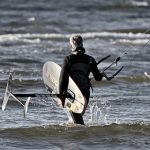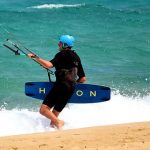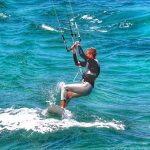Most kitesurfing accidents happen at the launch, so it’s not worth taking shortcuts. By taking the right precautions, your session will start happily.
This is not designed to replace lessons from a qualified instructor. This is designed to be a revision to prepare yourself before you go out alone.
How to Launch a Kite Safely [Assisted]
If you’re just starting out with kiteboarding, you shouldn’t try to launch the kite by yourself. If something goes wrong, you could seriously hurt yourself or other people nearby.
Do not ask someone who does not know how to kite to launch for you as both the person launching and the person being launched need to know what they are doing.
Safety Check
It’s time to check the launch area to make sure there are no obstacles that could impede take-off.
You should hold the bar and walk in a curved line towards the wind, making sure that there are no obstacles in the way.
Often, on busy beaches, you will find that someone has set up their kite between you and the water by the time you have set up yours. Although it is not ideal, just be careful to lift your lines high enough to clear any obstacles safely.
What’s the best way to get the kite in the air? Try to find a clear area nearby and have your assistant walk towards it while you hold the bar with the kite’s lines.
Getting Into Position
First, you should put your board in a safe place, away from the lines. It’s not uncommon for boards to get caught in the lines, which can cause a lot of problems.
I usually put my board between where I’m standing to launch and the water.
Attach the safety leash to the lines, connect the chicken loop to the hook, and make sure the “chicken stick” is inserted through the hook.
You attach the leash first and the chicken loop second in order to make sure you are not attached to an unsecured kite. That way, if you suddenly need to release the chicken loop by firing the primary safety, the kite will not blow away downwind with the lines dragging behind.
Attach the safety to your harness and disconnect from the kite. Walk backward until there is tension in the front lines. Do not hold the bar, just let it hang in front of you.
Attach the safety to your harness and disconnect from the kite.
Check that the lines are all separate and there are no bits of twig or shells attached to the line.
If you’re having any issues at this point, give your assistant the thumbs down signal and wait until they land the kite. Then unhook yourself and sort out the problem.
Assuming the lines are in good condition, start walking in an arc towards the wind, keeping the front lines under tension but not holding on to the bar.
This way, as you walk out the kite will always be going upwind. You can walk either direction, left or right, to go upwind. I always prefer to launch the kite with the kite on the shoreline and inland. This way, as you walk out the kite will always be going upwind.
This ensures that if you are suddenly thrust with energy, you will be pulled towards the water rather than any obstacles on land.
While it is not possible in all cases due to space or wind direction, it is ideal to choose this option when possible.
By maintaining tension in the front lines, you can walk with the lines off the beach so they don’t get snagged. This also allows you to tell when you are in the correct position, as you will feel the kite begin to pull slightly.
It is best to start with the kite at a 90 degree angle to the wind, and very slightly downwind of you.
When you are in the correct position, the kite that your assistant is holding with one end down and one up will start to fill with wind and stop flapping.
If you get too close to the kite, it will start to push forward. Take a few steps back until the kite is in your assistant’s hands. The kite should be supported by the wind, but not trying to push backward or forwards.
Getting the kite positioned correctly is key, as if it’s too far downwind it will take off rapidly when powered up, which could result in you being dragged along the ground or lifted off into the air.
If the kite is too far upwind, it will start to drift away from the downwind as soon as your assistant lets go, which could either injure someone else on the beach or cause the kite to power up with a jolt.
In the ideal position, you can raise the kite directly overhead.
The Launch
Hold the bar in your left hand with the red or brightly colored side facing you.
You should keep one hand on the bar close to the center line at all times during the launch process. The other hand should be ready to pull the primary release on the chicken loop in case a gust of wind catches the kite and launches it downwind or up into the air.
Grip the bar lightly at this point, checking that the trim is adjusted correctly.
Don’t pull too hard on the bar when you’re flying the kite; you should be able to feel how much pressure is on the bar in the de-powered position.
The kite shouldn’t be trying to pull in that position; if it is, then pull down on the de-power line a bit. If the kite is still pulling with the de-power line all the way down, then you may have the wrong size kite.
Don’t try to launch a kite that is too powerful for you. It is the most common cause of kite surfing accidents. I have the scars to prove it!
Check the area around you for any kites that are in the air before you launch.
When you want to signal to your assistant that you are ready, hold up your thumb. As they release the kite, guide it up towards the 12 o’clock position.
Now check if your kite is trimmed properly. The kite should feel comfortable with the bar in the midway position when you are in the water.
However, if you have to walk a bit to get to the water, it is better to trim the kite so that it stays in the air, but does not try to pull you down the beach, when the bar is in the midway position.
This makes it less likely that you’ll be thrown down the beach or into the air by a sudden gust of wind.
Getting to the Water
The key is to avoid any tight situations where you may lose control. You should avoid launching in a crowded area of the beach as a beginner. If it is busy, you need to be constantly aware of other kiters. The key is to avoid any tight situations where you may lose control.
If you are on the beach, be careful of people who are coming out of the water, as they may not be able to control their kite well. The best thing to do if you are unsure is to keep your kite up high, at about 12 o’clock, and wait for the other person to get clear.
If you are walking towards the water, the best place for the kite to be is at 10 or 2 o’clock. Having the kite at 12 o’clock is more comfortable, but there is a greater risk of the kite pulling you into the air if the wind is strong.
While you may see experienced kiteboarders carrying their kite at the 12 o’clock position, it is ideal to keep it lower.
Two of the most common problems
- Riders that create (or allow) line tension from an angle that is too far upwind of the edge of the wind, resulting in a kite that is pressing hard into the assistant, or pulling the rider forward and allowing the kite to “fold” or “bend” over the assistant, or worse.
- Riders that are too far downwind of the edge of the wind and signaling for their fluttering, powerless kite to be released, only to stand and watch as it falls back and onto the trailing edge, usually followed by the kite rolling downwind (into the “power zone”).
These tips are mostly for the person flying the kite (the rider). The rider is responsible for making a successful launch, while the assistant’s job is just to hold the kite until the rider takes off.
The Technique
Start by positioning yourself downwind from where you think the edge of the wind is in relation to your kite. Keep in mind that the edge of the wind is at a right angle to the wind direction. This means that it is across the wind from the kite.
A good reference point is to start by positioning yourself halfway between the kite and the downwind direction. From this downwind location, you can have someone hold the kite in place while you do a “final line check.”
This involves tensioning the lines and making sure they are all rigged correctly. Wait to hook up to your control bar until after you have done the “final line check.”
Stand with the kite hooked up and the center lines taught. There should be enough tension on the lines so you are pulling the kite and launch assistant slightly toward you, but not so much that you are ripping the kite out of their hands or forcing them to take more than a small step closer to you.
You’ll feel the tension on the lines and in your harness.
Move upwind while maintaining tension on the center line. As you approach the edge of the wind, hold the control bar IN toward the kite with a light grip, to keep the power on and the back line taut.
The edge of the wind is not a static location, it is constantly changing with the wind strength and angle.Grip the bar lightly and let it slide in and out to manage the pull of the kite as you catch the wind.
Don’t try to fly your kite too high too quickly. It’s really uncomfortable for an experienced launch assistant to hold a kite that’s being pulled aggressively upward during a launch.
A smooth launch should involve just hovering the kite a few feet off the ground. Slowly bring it up to just a few feet above the launcher, or maybe halfway up the side of the wind, while you’re checking to see that the kite is properly tuned and that the wind conditions are good.
It’s not good to send a kite high into the sky and above your head in the first few seconds of flying, before you have a chance to confirm that everything is okay.
In summary
- Begin well downwind of the edge of the wind
- Maintain line tension and keep the bar in (lightly) while walking upwind until you find or catch the wind.
- As the kite catches the wind, take the force of the kite using your bodyweight, don’t let it pull you towards it, continue walking into the wind as the kite is launched, keeping a relaxed grip on the bar and sheeting out or in as necessary.
- Don’t steer the kite aggressively upwards during the launch.



